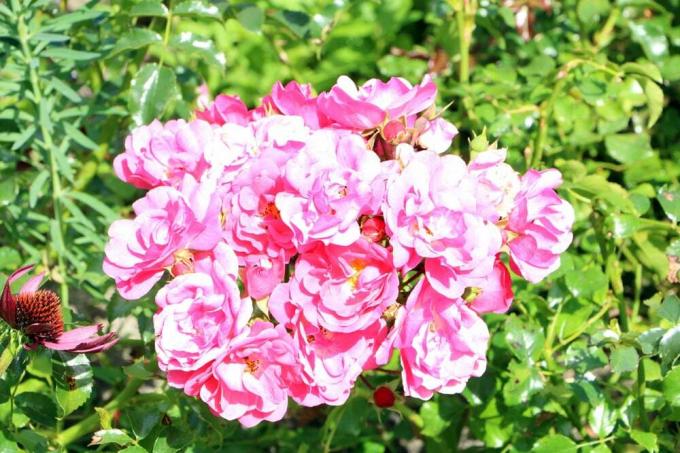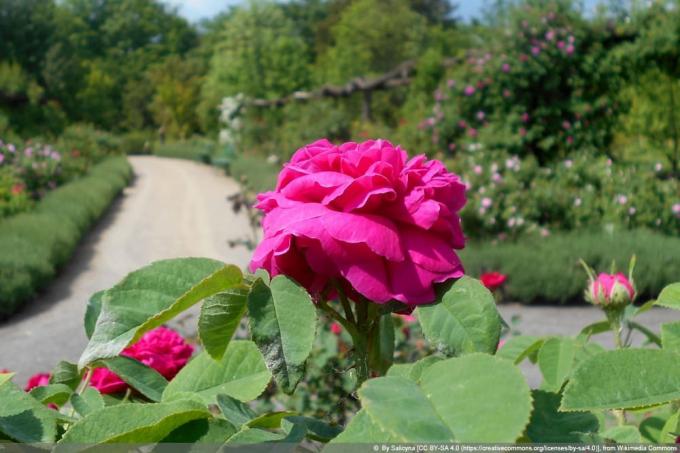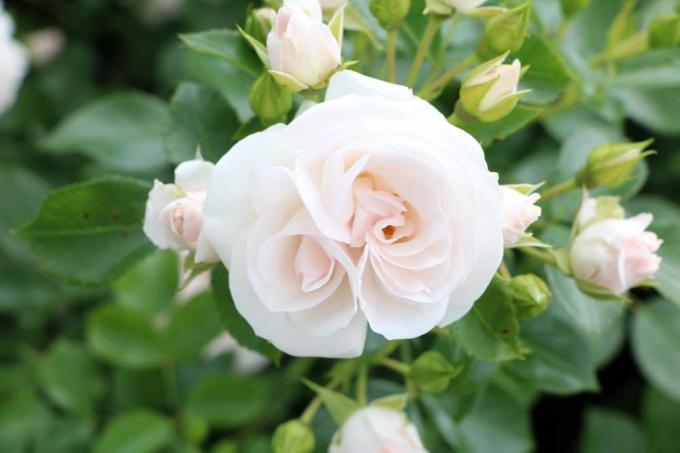

Table of contents
- Location
- Tubs & plant substrate
- Planting & repotting
- watering & fertilizing
- Cut
- hibernate
If you don't have your own garden, you can also cultivate roses in tubs on the balcony or terrace. The beautiful flowers thrive magnificently in summer, but these deep-rooted plants have certain requirements in terms of care, pot size and location. Over time, repotting is also necessary, as the roots continue to grow and need more space in the planter.
Location
When roses grow in pots, they make special demands on the location. Depending on the time of year, solar radiation and temperatures, these requirements are constantly changing. Since the bucket is mobile, moving is therefore advisable based on the prevailing conditions. If the spots are too hot and have a continuous canopy, then the roses will be extremely stressed. This quickly leads to problems with pests, especially mildew and spider mites. Rose varieties with small foliage tolerate strong sun rays and prolonged heat much better than large-leaved varieties.
- Location should be sunny for a few hours daily
- Light penumbra is ideal
- Full sun is not well tolerated
- West or east side is ideal
- Too much heat builds up on south walls
- Ensure adequate ventilation
- Not covered permanently
- Place in an empty spot until flowering
- Cover for a few weeks during flowering and hot temperatures
- Roofing must have adequate ventilation
- After flowering, put them back in an open spot
Tubs & plant substrate
When planting, it is important to ensure that the pot is large enough. Since roses have extremely deep roots, they require a correspondingly large amount of space in the planter. The roots should never touch the walls in the bucket or pot. The material does not play such an important role in the rose pot as its dimensions. However, roses make high demands on the nutrient content of the plant substrate and do not tolerate prolonged moisture in the pot. Therefore, special rose soil is perfect for the plants, as their structure is significantly coarser than that of normal potting soil. Thanks to this structure, the plant is protected from permanent waterlogging. In addition, this soil contains draining components and optimal acidity, which promotes root growth.
- Use tubs with a height of at least 50 cm
- diameter of at least 40 cm
- Noble, climbing and shrub roses need a pot height of at least 70 cm
- Pots made of plastic, fiberglass and terracotta are possible
- Nutritious rose soil is ideal
- Alternatively, use soil for potted plants
- Enrich the substrate with calcareous rock flour
- Renew plant substrate annually, if possible in spring
Tip:
You can also produce a nutrient-rich plant substrate yourself by mixing about 30 percent compost with high-quality potting soil, which consists of clay and sand.
Planting & repotting

Before planting in the pot, treat roses in the same way as if the flowers were going into a garden bed. When planting in the pot, care should be taken to ensure that there is a sufficient pouring edge so that the irrigation water cannot run over the edge of the pot when watering. Not too many roses should be planted in a pot, although they would fit several in a larger planter. After a short time, the plants compete for the available water, nutrients and root space. Roses have to be repotted after a few years because they have strong root growth. If the plants no longer have enough space in the bucket, this has a negative effect on above-ground growth. When repotting, careful handling is very important in order not to damage the sensitive roots unnecessarily.
- Place container roses in a water bath before planting
- Cut back bare root plants
- Plant in the middle when planting, at a distance from the walls
- Cover the root ball with about 2 cm of two plant substrate
- Grafting point should be at least 5 cm above the ground
- Leave a pouring edge of about 5 cm
- A continuous drainage is important
- Lay out a layer of potsherds or pebbles over the drainage hole
- Above that, a drainage layer of expanded clay or lava chippings, approx. 3-5 cm
- No more than 2 roses per planter
- Repot tub roses into a larger planter every 3-4 years
- Proceed as for planting
watering & fertilizing
If roses in the tub are not supplied with enough nutrients, then in extreme cases they will not even bloom. It is therefore important to ensure an adequate supply of nutrients. If the plants overwinter outside, they should no longer be fertilized from mid-June. Otherwise the plants would continue to develop new shoots that would not have enough time to mature well before the winter cold and would therefore be very susceptible to frost damage. If overwintering in a frost-free winter quarters is possible, then the plants should be fertilized throughout the growing season. Potted roses are also very demanding when watering, the flowers don't like it too dry or too wet. Therefore, the irrigation water must always be able to drain off well, since the delicate flowers do not tolerate permanently wet feet.
- Water regularly, but not too much at once
- The top layer of soil should dry first
- Root ball should never dry out completely
- Avoid waterlogging at all costs
- Ideally, fertilize for the first time in spring
- Potted roses prefer long-term and liquid fertilizers
- Help with liquid fertilizer during flowering
- Give additional potassium fertilizer between mid-August to late September
Cut

When pruning potted roses, the same rules should be followed as with ordinary roses. This should only be started when the heaviest frosts are largely over. Pruning can be radical, except for once-blooming shrub or climbing roses. These varieties should only be shortened slightly. When pruning, growth should be encouraged, the roses should not sprout inwards. Good cutting tools are important in order not to unnecessarily squeeze the shoots
- Perform pruning in spring
- Prune shoots back to three eyes
- The last eye should always face outwards
- Place the cut about 5 mm above the eye
- Cut at a slight angle so that the water drains off faster
- Be sure to use very sharp pruning shears
- Always cut back immediately in the event of a fungal attack
hibernate
In winter, potted roses still need care and must be protected from severe freezing temperatures. Ideally, the plants can be moved indoors, but not in a basement or dark attic, as light is still needed. However, it is also possible to hibernate at the usual location, but then certain protective measures must be observed. Since there are often strong storms in winter, the above-ground shoots must be protected from wind damage.
- Moving to frost-free winter quarters is ideal
- Cool guest rooms, bright corridors and bright attics are well suited
- Continue watering in winter, but stop fertilizing
- When overwintering outdoors, be sure to protect roots
- Wrap thick bubble wrap around the tub, about 10 cm
- To insulate, place the bucket on Styrofoam or a coconut mat
- Cover exposed shoots with brushwood or burlap
 garden editorial
garden editorial I write about everything that interests me in my garden.
Learn more about types of roses

Pruning wild roses: 6 tips for trimming wild roses
Wild roses should not be missing in any natural garden. They are easy to care for and bloom on two-year-old wood. The delicate blossoms and autumnal rosehips enchant the garden well into winter. To maintain their beauty, however, some maintenance is necessary.

18 historical roses with picture | Varieties of roses for the home garden
Creating a rose garden is not as easy as you might think. The gardener often only becomes aware of the variety of different flower colors on the market when the purchase decision is imminent. So that the selection does not have to be made spontaneously and that it takes into account both the appearance and the location requirements can be optimally adapted to the circumstances of his garden, he will find an overview of 18 historical ones here varieties of roses.

Moss rose (Rosa centifolia var. muscosa): care from A to Z
The moss rose (Rosa centifolia var. Muscosa) is a profusely flowering old rose variety that resulted from a bud mutation. The special thing about her is the green to brownish moss on the buds, sepals and flower stalks and their sweet, slightly resinous scent.

Making roses winter-proof: fleece, bark mulch & Co | Ideal time
Roses depend on good winter protection so that the royal blooms can be repeated next year. The focus is on specific precautions for the crown, trunk and roots, tailored to the respective rose type. This guide gives a practical explanation of when and how to best winterize your roses.

Create a rose bed: easy to care for with roses, perennials and stones
The rose is not considered the queen of flowers for nothing. Her beauty is simply incomparable. It goes without saying that under these conditions it belongs in every garden. Here you can learn how to properly plant a rose bed and properly care for the royal plants.

Rose planting time: when is the best time to plant roses?
Roses have the potential to spark a passion for collecting. Each strain is different, be it flower shape or color. With these noble flowers, there is never a dull moment in the garden. When is the best time to plant new roses?



